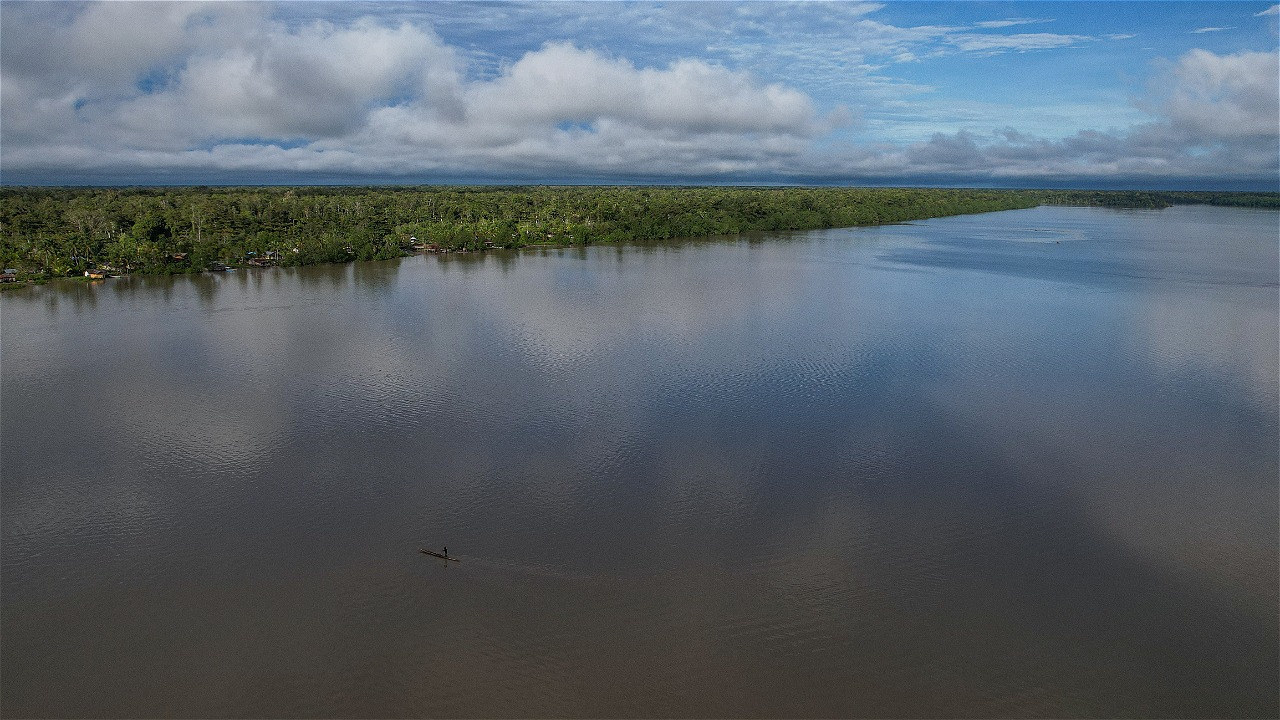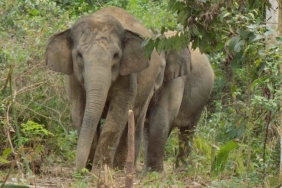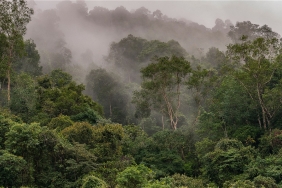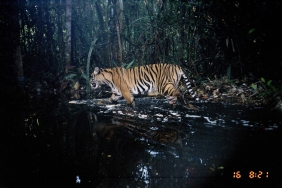POTENTIAL FOR ENVIRONMENTAL SERVICES IN PEUSANGAN, JAMBO AYE & TAMIANG LANDSCAPES, ACEH
By: Agus Haryanto (WWF-Indonesia) and Abdul Halim (Krueng Peusangan Watershed Forum)
Damage to the Peusangan, Jambo Aye and Tamiang (PJT) watershed ecosystems is a time bomb for the 2.5 million people on Aceh's east coast. Damage to watershed ecosystems can disrupt water sources so that the threat of a water crisis in the future will be a frightening specter because water is the source of life.
Deforestation, illegal mining, oil palm plantations and forest encroachment and excavation C are a series of problems that occur in the three large watersheds. The presence of unsustainable palm oil plantations in this landscape adds to the list of problems, such as a number of palm oil companies operating in Bireuen, North Aceh, East Aceh, and Aceh Tamian that still do not apply sustainable plantation principles.
The main problem point of disturbance for watersheds in this region is the first rank of excavation C where the correlation between the level of infrastructure development and the number of excavation C permits. For the Tamiang watershed there are 52 IUPs, in the Peusangan watershed there are 36 IPUs and the Jambo Aye watershed there are 14 IUPs, which is very worrying for the damage to the river itself.
Also the existence of a number of oil palm plantations, the rampant granting of excavation C permits because part of the company's concession area must be protected, both high conservation value areas, water absorption areas, and water sources. But the company does not carry out its obligations in accordance with the mandate of Law Number 39 of 2014 concerning Plantations. This issue is a big problem for drinking water companies, both regional companies and private companies.
WWF-Indonesia, FDKP, and BSUIA are currently implementing the SRJS (Shared Resources Joint Solutions) Aceh program in the PJT landscape (Peusangan, Jambo Aye and Tamiang), as one part of the SRJS Aceh program is the development of environmental service fee / PES schemes in the watershed. For this reason, a workshop on the development of PES was held on 25-26 September 2018 in Lhokseumawe with the participation of all relevant stakeholders, including representatives of the central and local governments, academics, the private sector, and community organizations in the PJT landscape.
Isfadli Yahya, SE, Director of PDAM Krueng Peusangan at the Environmental Services Fee Workshop held by the SRJS Aceh program on Tuesday (25/09) in Lhokseumawe, admitted that the cost of producing clean water by PDAM Krueng Peusangan is quite large because mining activities carried out downstream cause turbid river water. "In addition to mining, the taking of large stones also disrupts the watershed ecosystem, where large stones as water buffers are no longer available, so that during the rainy season, water by itself is discharged into the sea through the river," he said. "The PDAM has collaborated with FDKP in the implementation of Environmental Services Fee in the upper Pandrah sub-watershed, Bireuen. This program has successfully restored critical land there," Isfadli said.
Meanwhile, Michael Riwu Kaho, Chairman of the NTT Watershed Forum told about his arid homeland, but NTT became one of the areas often visited by parties who wanted to manage watersheds, because NTT successfully managed watersheds in an integrated and sustainable manner.
To manage watersheds in an integrated and sustainable manner, he invited multi-stakeholders to contribute to realizing sustainable watersheds. Although there are almost no companies in NTT, the concept of multi stakeholder is still carried out to realize watershed management, because watershed problems are common problems and must be handled together from upstream, middle and downstream.
Dr. Rini Fitri, an academic at Almuslim University, Peusangan, said that the general watershed problems in Indonesia include floods, droughts, landslides, sedimentation, forest and land degradation, limited government funds, low levels of income and population participation, conflicts between interests upstream and downstream, water and soil pollution.
"The ideal watershed characteristics are able to provide high land productivity, able to ensure watershed sustainability, able to maintain equitable distribution of farmers' income (equity) and able to maintain watershed sustainability against shocks that occur (recilient)," Rini said.
Irwandar, from Yayasan Usaha Lestari Indonesia, explained that water is a common need for all living things. In addition, businesses are also very dependent on water sources (industries, offices, hotels, shopping centers, PDAMs, etc.).
"Damage to watershed ecosystems can threaten water supply scarcity (drought), weak water management and availability (rural/urban) is also a problem of water governance," said Irwandar, a former staff of the Public Relations department of PT Arun NGL Lhokseumawe.
Irwandar explained that water use also often causes conflict in the community. Therefore, a collective policy to maintain the existence of water is needed. He also mentioned the importance of shared awareness about the future of water.
Agus Haryanto from WWF-Indonesia told at length about Environmental Services Fee and the challenges of implementation in Indonesia. One of the success stories of the implementation of Environmental Payments assisted by WWF-Indonesia is the agreement with PDAM Menang Mataram, Lombok in 2009 in terms of implementing environmental service payments by 40,000 PDAM water customers.
"Environmental Services for households amounted to Rp1,000.00 and offices amounted to Rp2,000.00. Of the total allocation of public funds for Environmental Services, 75% is used for nature and society, while 25% is for program operations," Agus explained.
According to Azhar (WWF-Indonesia Northern Sumatra Program), the development of Imbal Jasa Lingkungan in Aceh has specifically been carried out in the Peusangan watershed through a voluntary scheme, namely several large companies in the North Aceh area, such as PT Arun LNG and PT Pupuk Iskandadar Muda (PIM) as water users from Krueng Peusungan, willing to use the environmental service fee scheme in 2011. Imbal Jasa Lingkungan is generally present because there is a mutual understanding between the company and stakeholders and an approach and socialization is needed for the activities of this environmental service fee issue in other companies in the North Aceh industrial area.
Potential of Environmental Service Fee in Peusangan, Jambo Aye and Tamiang Watershed
Success stories of integrated and sustainable watershed management are not difficult for the three major watersheds in coastal Aceh. The potential for PES implementation in the Peusangan, Jambo Aye and Tamiang watersheds is considerable. A number of water companies, both local and private, operate in these three landscapes. In addition to drinking water companies, mining, plantation and industrial companies also operate. However, the awareness of the parties about the importance of managing watersheds in an integrated and sustainable manner is still not considered by the parties.
In addition to the lack of willingness to manage watersheds as water providers, a number of companies also take refuge behind Law Number 28 of 2009 concerning Regional Taxes and Regional Contributions. They argued that their companies have already paid the contribution tax, and surface water tax. Then why should they give back the voluntary Environmental Services Fee?
The company's stronghold is indeed powerful. They have fulfilled their obligations to pay taxes and levies, but the management by the government has been inversely proportional. The surface water tax, non-metallic mineral and rock tax, and groundwater tax paid by companies are not utilized to rehabilitate and restore critical land in the upper and middle watersheds as a form of watershed management. Because of this, damage to the watershed ecosystem continues to occur, posing a threat to humanity, especially drought and flash floods.
Behind the story above, there is actually a great opportunity in efforts to develop PES (Environmental Services Fee), especially water in the Peusangan, Jambo Aye and Tamiang watersheds. This is due to several facts, among others: 1) Clarity of the main commodities for PES implementation, which in this case is the sustainable management of Water Environmental Services to realize integrated and sustainable watershed governance; 2) PES implementation has previously been carried out in the Peusangan watershed, learning from this location is certainly very valuable and a great opportunity to be replicated in the other two watersheds, namely the Jambo Aye and Tamiang watersheds; 3) The condition of the watersheds in the PJL landscape (Peusangan, Jambo Aye and Tamiang) is already in a critical and alarming condition, as evidenced by several disasters, both floods and droughts that have occurred. Finally, the potential development of PES (Environmental Services Fee) is also very likely to be developed in the PJT landscape with the existence of a legal umbrella of legislation at the national level, namely with the issuance of Government Regulation (PP) Number 46 of 2017 concerning Environmental Economic Instruments in which the development of an Environmental Services Fee / Payment scheme is possible.< br />
Optimization of Watershed Forum
The Krueng Peusangan Watershed Forum and the Jambo Aye Watershed Forum, which have received legality from the government, need the support of the parties, especially the district / city governments that are included in the Watershed, so that integrated and sustainable watershed management efforts can be implemented properly.
Efforts to implement Environmental Services Payments (PES) must also be encouraged by the parties, including the government, companies, and non-governmental organizations. The implementation of PES itself can be carried out by an institution formed by the parties through a watershed forum, so that planning, implementation and monitoring can be carried out by the watershed forum which is a multi-stakeholder forum.
While the Tamiang watershed that has not yet formed a das forum must take concrete steps, where the parties in Tamiang must invite the parties to the formation of the Tamiang Watershed Forum. This multi-stakeholder forum will play a role in managing the Tamiang watershed in an integrated and sustainable manner. The Krueng Aceh Watershed and Protected Forest Management Center (BPDASHL) as an extension of the Ministry of Environment and Forestry in the region must encourage the acceleration of the formation of the Tamiang Watershed Forum.
Other things that are still a big challenge in efforts to implement and develop PES (Environmental Services Fee) in the PJT landscape include: 1) The need for wider public participation because in the context of watershed management must be carried out in an integrated and integrated manner. One of the things that needs to be encouraged is the existence of a joint multi-stakeholder/multisector agreement to jointly save the watershed; 2) Efforts are needed to increase the capacity of (existing) institutions, both watershed forums and other related forums to jointly become PES management institutions in the PJT landscape; 3) Another urgent and important thing that is needed is the existence of a legal umbrella at the regional level. In this regard, there needs to be a strong push to immediately finalize and ratify the draft Qanun on watershed management and environmental services that already exist.





